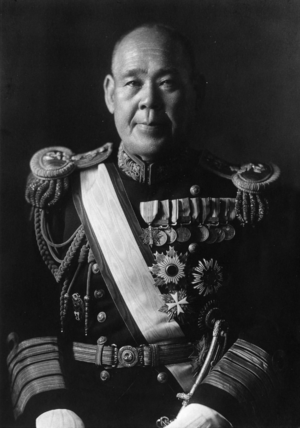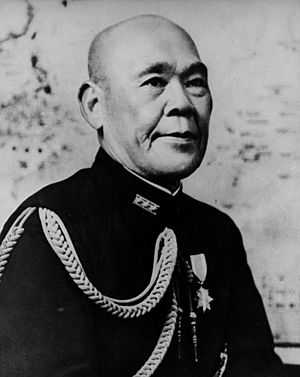Osami Nagano facts for kids
Quick facts for kids
Marshal Admiral
Osami Nagano
|
|
|---|---|
|
永野 修身
|
|

Osami Nagano, c1940
|
|
| Minister of the Imperial Japanese Navy | |
| In office 9 March 1936 – 2 February 1937 |
|
| Monarch | Shōwa |
| Prime Minister | Kōki Hirota |
| Preceded by | Ōsumi Mineo |
| Succeeded by | Yonai Mitsumasa |
| Chief of the Imperial Japanese Navy General Staff |
|
| In office 9 April 1941 – 21 February 1944 |
|
| Prime Minister |
|
| Preceded by | Prince Fushimi Hiroyasu |
| Succeeded by | Shimada Shigetarō |
| Personal details | |
| Born | June 15, 1880 Kōchi, Kōchi Prefecture, Japan |
| Died | January 5, 1947 (aged 66) Sugamo Prison, Tokyo, Occupied Japan |
| Awards |
|
| Military service | |
| Allegiance | |
| Branch/service | |
| Years of service | 1900–1947 |
| Rank | |
| Commands |
|
| Battles/wars | World War I, World War II |
Osami Nagano (永野 修身, Nagano Osami, June 15, 1880 – January 5, 1947) was a Marshal Admiral of the Imperial Japanese Navy and one of the leaders of Japan's military during most of the Second World War. In April 1941, he became Chief of the Imperial Japanese Navy General Staff. In this capacity, he served as the navy's commander-in-chief in the Asia-Pacific theater until his removal in February 1944. After the war, he was arrested by the International Military Tribunal for the Far East but died of natural causes in prison during the trial.
Contents
Early life and career
Nagano was born in Kōchi to an ex-samurai family. In 1900, he graduated from the 28th class of the Imperial Japanese Naval Academy, ranking second in a class of 105 cadets. After completing service as a midshipman on the cruiser Hashidate and the battleship Asahi, he was commissioned an ensign and assigned to the cruiser Asama. During the Russo-Japanese War, he served in a number of staff positions. The closest he came to combat was commanding a land-based heavy naval gun unit during the siege of Port Arthur.
After his promotion to lieutenant in 1905, Nagano served on the battleship Shikishima. From 1905 to 1906, he studied naval artillery and navigation. From 1906 to 1908, he was chief gunnery officer on the cruiser Itsukushima. In 1909, he graduated from the Japanese Naval War College.
In 1910, Nagano was promoted to lieutenant commander and assigned as chief gunnery officer on the battleship Katori. From January 1913 to April 1915, he was a language officer in the United States, during which time he studied at Harvard Law School.
During World War I, Nagano was executive officer on the cruisers Nisshin and cruiser Iwate. In 1918, he was promoted to captain. In 1919, he received his first (and only) ship command, the cruiser Hirado.
From December 1920, Nagano was a military attaché to the United States. In this capacity, he attended the Washington Naval Conference. In November 1923, he returned home, although he returned to the United States on official visits in 1927 and 1933. In December 1923, he was promoted to rear admiral.
In February 1924, Nagano was chief of the Imperial Japanese Navy General Staff Third Section (Intelligence). From December 1924, he commanded the 3rd Battleship Division. From April 1925, he commanded the 1st China Expeditionary Fleet. In December 1927, he was promoted to vice admiral.
From 1928 to 1929, Nagano was commandant of the Imperial Japanese Naval Academy. Nagano introduced and influenced Progressive education method such as Dalton Plan to Japanese Naval Academy.
From 1930 to 1931, he was vice chief of the Navy General Staff, in which capacity he attended the Geneva Naval Conference. He attended the London Naval Conference 1930. From 1933 to 1934, he was commander in chief of the Yokosuka Naval District.
On 1 March 1934, he was promoted to admiral and appointed to the Supreme War Council. Nagano was the chief naval delegate to the London Naval Conference 1935. Japan withdrew in protest from the 1935 London Conference after it was denied naval parity with the United States and Great Britain.
In 1936, Nagano was appointed Navy Minister under Prime Minister Kōki Hirota. Later in 1937, he became commander-in-chief of the Combined Fleet. By April 1941, he had risen to the very top of the Japanese Navy leadership to become chief of the Imperial Japanese Naval General Staff.
World War II
A staunch believer in Nanshin-ron , Admiral Nagano played a central role in Japan's decision to go to war with the United States. After Japanese forces occupied southern Indochina on 24 July 1941, the U.S. and its Western Allies froze Japanese assets within their borders thereby resulting in a halt on all oil shipments to Japan. At the end of the month, Nagano informed Emperor Hirohito that the nation's oil supply would run out in two years if the embargo was not lifted. Consequently, he advised that Japan should be ready for war within that timeframe if attempts at diplomacy failed.
By September 1941, he and the Army's Chief of Staff, General Hajime Sugiyama, called for Japan to be placed on an immediate war-footing and for an end to all negotiations by mid-October.
According to some Japanese sources, Nagano presented a peace proposal before a conference on November 1, 1941 but this was ultimately struck down by Prime Minister Tojo Hideki..
After learning about the issues of launching a 'surprise attack' on the naval fleet of the United States in Pearl Harbor since he viewed it as a needless diversion of Japan's carrier fleet and a risky proposition for the entire Empire, Nagano initially opposed Admiral Isoroku Yamamoto's planned attack on Pearl Harbor, but reluctantly gave his approval for the attack after Yamamoto threatened to resign as Combined Fleet commander.
In 1943, Nagano was promoted to marshal admiral. By 1944, however, Japan had suffered serious military setbacks and Nagano had lost the confidence of Emperor Hirohito. With the emperor's approval, Prime Minister Hideki Tōjō and Navy Minister Shigetarō Shimada removed Nagano from his post and replaced him. Nagano spent the remainder of the war as an advisor to the government.
Remark
- According to the opinion of the Japanese government, if Japan accepts the demand of the United States, Japan will perish. However, even if Japan fights against the United States, Japan may perish. That is, accepting the request of the United States will destroy Japan without fighting the United States. Even if we fight against the United States, if Japan can not avoid the danger of extinction, if Japan defeats without fighting with the United States, the Japanese people will truly disappear from the earth. However, if Japanese people can fight and show the spirit of defending Japan, even if Japan fights against America, our descendants will always rebuild Japan. We hope to solve problems in diplomatic negotiations. But unfortunately we will be fighting if we are to be commanded to wage war.(September 6, 1941, Osami Nagano)
| IJN Insignia | Rank | Date |
|---|---|---|
 |
海軍少尉候補生 Kaigun Shōi Kōhōsei (Midshipman) |
13 December 1900 |
 |
海軍少尉 Kaigun Shōi (Ensign) |
18 January 1902 |
 |
海軍中尉 Kaigun Chūi (Sub-Lieutenant/Lieutenant Junior Grade) |
26 September 1903 |
 |
海軍大尉 Kaigun Daii (Lieutenant) |
12 January 1905 |
 |
海軍少佐 Kaigun Shōsa (Lieutenant-Commander) |
1 December 1910 |
 |
海軍中佐 Kaigun Chūsa (Commander) |
1 December 1914 |
 |
海軍大佐 Kaigun Daisa (Captain) |
1 December 1918 |
 |
海軍少将 Kaigun Shōshō (Rear-Admiral) |
1 December 1923 |
 |
海軍中将 Kaigun Chūjō (Vice-Admiral) |
1 December 1927 |
 |
海軍大将 Kaigun Taishō (Admiral) |
1 March 1934 |
 |
元帥海軍大将 Gensui Kaigun Taishō (Marshal-Admiral) |
21 June 1943 |
See also
 In Spanish: Osami Nagano para niños
In Spanish: Osami Nagano para niños


